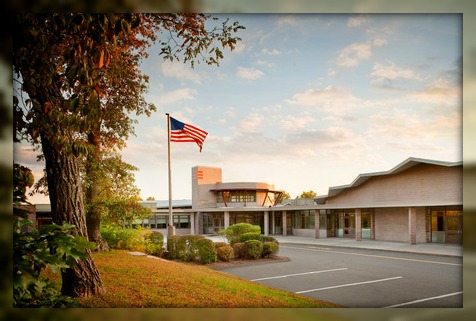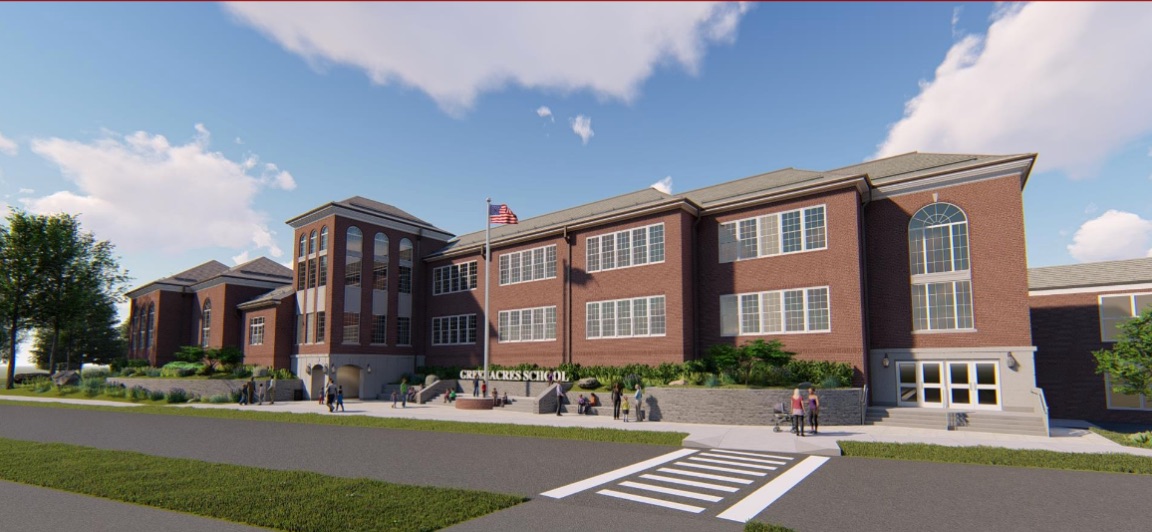Environmental Hazards Pose Risks to Children in Schools: Speak Up Now
- Category: Schools
- Published: Wednesday, 21 November 2018 07:24
- Joanne Wallenstein
 Coleytown Middle School in Westport is closed due to mold.Two news stories from other school districts came to my attention this week -- one involving the complete closure of a middle school in Westport, CT due to mold --and another about lead in the water in schools in Detroit, Michigan.
Coleytown Middle School in Westport is closed due to mold.Two news stories from other school districts came to my attention this week -- one involving the complete closure of a middle school in Westport, CT due to mold --and another about lead in the water in schools in Detroit, Michigan.
Why is this relevant to Scarsdale? Read below:
From the Westport News, “After a two-year saga fighting mold strung along while students remained in class, Coleytown Middle School will now be shuttered for the remainder of the year. The relocation of 450 Coleytown students grades six through eight first appeared to be a temporary fix but has now become a permanent solution, according to officials. “
Another story explains, “It’s more than 50 years old. It was built hastily, to house the postwar baby boom generation that was flooding Westport schools. A major renovation in the 1990s made its hallways more navigable, its curves less quirky and its classrooms more pleasant.
But it’s tough to fight mold.
Westport is in the first phases of deciding what to do with Coleytown Middle School. Experts are still trying to identify the causes of physical symptoms experienced by students and staff. Reports will be followed by debates. District administrators, the Board of Education, Board of Finance and the public — particularly parents — will weigh in. Can — and should — the school be renovated? Torn down? Meanwhile, what will happen to sixth through eighth graders, who currently share  Water fountains at Detroit Public Schools are dry due to lead.Bedford Middle School and Staples High?”
Water fountains at Detroit Public Schools are dry due to lead.Bedford Middle School and Staples High?”
Concerning school water quality, on November 15, in a story titled, “Not Far from Flint, Contamination Has Left Detroit School Taps Dry,” the New York Times reports all the water fountains were turned off in Detroit Public Schools in August after testing revealed elevated levels of copper and lead in drinking water at some schools. The article goes on to say that the problem in Detroit may be due to aging pipes, and explains, “Joints and other plumbing components often contain metals that can leach into the water over time.”
Why does this all sound familiar and why is it relevant to Scarsdale?
The Greenacres Elementary School, now more than 100 years old, will soon undergo a $28 million renovation. The school has aging plumbing and recurring outbreaks of mold. However the renovation does not include plans to replace the water pipes in the old building. Lead filters will continue to be required on fountains and faucets with elevated lead levels as it's too expensive to open up the walls and replace the pipes. * A $28 million renovation is planned for Greenacres. Have environmental issues been adequately addressed?
A $28 million renovation is planned for Greenacres. Have environmental issues been adequately addressed?
What about the mold? Efforts will be made to improve ventilation and dehumidify the basement, but the majority of the old building sits on a dirt foundation described as a crawl space, so it’s unclear how new ventilation will reach this space and reduce mold growth underneath the school. Air conditioning was promised for the eight new classrooms, however it is not listed on the documents provided by the district.
We asked Assistant Superintendent Stuart Mattey what will be done to address these issues during the renovation and his answers are below. Unfortunately he did provide a direct answer to some of my questions and rephrased others and answered his own questions. The environmental reports he cites for air quality are from 2015 when mold was found in Greenacres. Mold has been found again since that time. The water quality report is from 2016. The problems still exist.
Here are the questions I asked:
What is being done to address the dirt crawl spaces underneath the building that have mold? What short-term and long-term solutions are incorporated in the construction to address any current or future mold from these high moisture areas?
Given the presence of lead in the water, what, if any, pipes will be replaced? For any pipe not being replaced, what’s the short-term and long-term solution for water quality at the school?
(Please provide the) Most recent water quality reports for Greenacres
Ventilation: What will be done to improve the air quality in the old classrooms, the library and the gym? These rooms get too hot and damp in the warmer months.
Sustainability: what is specifically being done to make this century old building greener, cleaner and more energy efficient? How is the district sustainability committee involved in this process?
Parking and traffic plan. Prior to the bond vote Dr. Hagerman announced the district would work on a parking and traffic plan for the school. If this plan has not been completed, please provide a timeline for completion. The plan should include the current proposal to use the kitchen at Greenacres to transport food to other schools and parking for food service employees.
Here is his response:
Here is what I received:
“Dear Joanne: Thank you for your continued interest in the Greenacres project. You may find it reassuring that most of the issues you bring up were in fact studied, reported on, and thoroughly discussed by the Board and community members at the time the Bond Scope was determined. The items that were approved as part of the bond scope by District residents last February are indeed the items that will be included in the project specifications and eventually built as part of this project. All bond reports and environmental reports are available on the District website.”
For example, the question of mold was addressed in detail in a comprehensive report on air quality, which may be accessed here:
(Editor's note: The link is to a 2015 report. Mold was found again in 2017. There is no mention of the mold emanating from the dirt crawl spaces that are the foundation of the old building.)
Concerning water testing, the District has been most diligent, as can be seen in this report:
As was announced earlier this year, updates on environmental testing will be reported at regular intervals throughout the year at Board meetings.
(Editor's Note: This link is to a report from 2016. There is no mention of the lead filters on the drinking fountains and sinks)
Ventilation was thoroughly addressed in the Bond Scope:
Here’s an excerpt regarding this type of work at Greenacres:
Air Quality/Health Related
Install new unit ventilator system to improve ventilation in classrooms
Install commercial-grade dehumidification system for basement rooms; tie condensate to the sanitary system
Replace old boilers and burners that have exceeded their life expectancy
Abate and replace VAT flooring and Install roof (attic) insulation
Relocate drinking fountains
Improve drainage at window wells
Paint corridors, multi-purpose rooms, and the gymnasium
Sustainability issues were addressed under Frequently Asked Questions:
5. HOW ARE SUSTAINABILITY CONSIDERATIONS BEING ADDRESSED IN THE PROPOSED BOND SCOPE? The District’s architecture and engineering consultants, BBS Architects and Engineers, intend to employ many eco-friendly principles when developing construction plans, both in materials selection and interconnected component design. For example, new materials would be low VOC (Volatile Organic Compounds) and sustainable products, including adhesives, sealants, paints, coatings, flooring and wood products (casework and furniture). All new lighting will be high efficiency LED with vacancy sensor controls. All new heating and ventilation equipment will be high efficiency and provide for energy recovery where feasible. For the Greenacres expansion, projects will be designed following LEED (Leadership in Energy and Environmental Design) and CHPS (Collaborative for High Performance Schools) best practices and principles.
Parking and traffic concerns were also addressed under Frequently Asked Questions:
14. WHAT IS THE ANTICIPATED TRAFFIC IMPACT AT GREENACRES DURING CONSTRUCTION AND AFTER ALL WORK IS COMPLETE? WILL ANY CURRENT TRAFFIC PATTERNS BE CHANGED? A State Environmental Quality Review (SEQR) performed by J.C. Broderick & Associates, Inc., an environmental construction and testing company, has determined that construction at Greenacres will not have a significant adverse impact on traffic. As is the practice with all the other elementary buildings, at Greenacres, the District is working closely with the Village of Scarsdale and the Scarsdale Police Department to continue to identify effective ways to help traffic move smoothly for parents during drop-off and pick-up times.
As a matter of fact, I believe the Village just received an award for their work in this regard.
(Editor's Note: There is no mention of the loss of parking spaces, parking issues due to the increased number of employee cars working in the cafeteria, nor a discussion of the food trucks on Sage Terrace that will bring food to Greenacres and ferry meals back and forth to Fox Meadow School.)
As a reminder, all these documents and many, many more can be found in the Facilities and Grounds section of the website:
Sincerely,
Stuart P.G. Mattey, Assistant Superintendent for Business
Clearly it’s uncomfortable and unpopular in Scarsdale to speak of environmental hazards like mold and lead in our schools, but there is no denying that they pose a threat to children now and in the decades to come. When we look at what’s going on around the country, it’s evident that you can’t wish these problems away.
In my view, parents, neighbors and environmentally conscious residents should ask more questions and request a full and transparent environmental assessment of the existing building to find out if these issues can be adequately addressed in the upcoming renovation. Before taxpayers spend $28 million on a shiny new cafeteria, we should find out what it will cost to make Greenacres a safe, clean school. We don't want to spend money renovating now, before we have assurances that mold and lead will not cause big problems down the road.
Let's learn a lesson from Westport and Detroit. According to Dr. Hagerman, architects plans to submit the project to the State Education Department for approval within weeks, so action should be taken now.
* An April 2015 feasability study from former district architects KG&D said this about the school:
Ground water intrusion & high water table – The northern corner of the building has a lower level that routinely has odors and other evidence of some water intrusion. Despite several attempts at repairing the condition there does not seem to be any easy answer to this problem. It is likely the result of a high water table which varies seasonally and has many sub‐surface points of entry into the aging structure. With moisture penetration likely coming from under slabs and through walls that are significantly below grade it is difficult to imagine a cost‐effective method of repair. The condition could be made more tolerable with improved ventilation and air conditioning but will still require monitoring and could continue to make this portion of the building uncomfortable or inappropriate for student use. This area is currently used for Art, Music, Instrumental Music, Art Storage and mechanical support spaces.
Aging systems – The school did experience the collapse and failure of the main sewer pipe that exits the building a few years ago. This type of failure can be very disruptive and costly to repair in an emergency situation. Given the age of the building and the expected useful life of building materials and systems these types of failures are likely to continue. As a result the long term recommendation is to completely replace all of the original piping and plumbing systems that have not already been updated.







